Navigating Challenges in Hand Hygiene
Abstract:
Under National Policy on Hand Hygiene, HCPs need to follow and implement all the standard inro their practices to eliminate the risk of any healthcare associated infection. HCPs in the UK are obliged to follow the systematic process of HH throughout the care delivery to patients. In case of treating patients with infectious wounds in which there is high chances of bacterial colonisation, HCPs need to ensure all the safety standard are met under the national Policy of Hand Hyginus (HH). Thorough complying with all the safety standard under the national policy of HH, HCPs are able to maintain the aseptic environment surrounding the patient which reduce chances of spreading of any bacterial infection to the other people from the patient. While implementing the HH policy HCPs face several challenges that pose adverse impacts not only on their professional integrity as well as professional accountability but also impact on their mental and physical wellbeing. One of the most common challenges that HCPs face is lack of skill and professional knowledge of the healthcare staffs about how to follow and implement the standard of the national policy of Hand hygiene. This research is highly relevant to educate people, service users, service providers and heath care authority regarding the standard set under the National Policy on Hand Hygiene and the its implementation into the healthcare practices to reduces the chances of any bacteria of virus led infection. In this context, this research study will discuss the policies and procedure that are associated with complying with the National Policy on Hand Hygiene that health care professionals need to follow and implement into the practices to reduce the chances of different healthcare associated infection.

Introduction:
Hand hygiene can be referred as the act of washing and cleaning hands by soap or hand wash for removing all the bacteria, microorganism and viruses. NHS (2019) mentioned that, healthcare professionals must follow the protocol and procedures of hand hygiene in terms of eliminating chances of any kind of healthcare associated infection [NHS, 2019]. In the UK there are many cases of healthcare associated infection due to poor implementation of policies and acts regarding hand hygiene. NHS (2019) mentioned that, there are many cases in which both the healthcare staffs and the patients are infected by the healthcare associated infection during the care delivery to patients due to lack of skill and knowledge of staffs on how to implement and follow the hand hygiene policies [NHS, 2019].
NHS (2019) mentioned that, in the UK there are many cases in which healthcare professionals (HCP) fail to comply with the policy and standard of Hand Hygiene (HH), which not only interfere with safe care delivery to patients but also pose question on the professional integrity as well as professional accountability of HCPs (Hamilton and Leslie, 2014). In UK, many patients as well as healthcare staffs are diagnosed with the healthcare associated infection due to poor compliance with National Policy on Hand Hygiene. The healthcare associated infection makes people more vulnerable to then risk of mortality and morbidity in patients as well as in the healthcare staffs. NICE (2019) mentioned that, many cases of the inpatients’ deaths in NHS hospital have been registered during 2019, due to poor compliance with the National Policy on Hand Hygiene. NHS (2019) mentioned that, there are many cases in which healthcare staffs are infected with bacterial infection while dressing the pressure ulcer of diabetic patients. This is due to the improper cleansing and washing of staffs’ hand before and after dressing of patient’s wound which leads to close contact of staff’s hand with bacteria and virus thereby spreading the infection from one staff to the other. On the other hand, lack of knowledge of HCPs on the National Policy on Hand Hygrine and its implementation into practise leads to high chances of spreading of healthcare associated infection to other patients as well as other health and nursing staffs in the hospitals.
In this healthcare context of the ever-increasing numbers in healthcare associated infection due to the poor compliance of the HH policies into proactive, the selection of this topic is highly realistic and relevant. This research study on this topic will provide the evidence-based information on HH and its policies to the healthcare professionals that they can use in the care delivery to maintain high level of patient’s safety. On the other hand, this research study will also raise public awareness on the importance of the HH policies and the procedures of maintaining proper HH. Moreover, this research is highly relevant to educate people, service users, service providers and heath care authority regarding the standard set under the National Policy on Hand Hygiene and the its implementation into the healthcare practices to reduces the chances of any bacteria of virus led infection. In this context, this research study will discuss the policies and procedure that are associated with complying with the National Policy on Hand Hygiene that health care professionals need to follow and implement into the practices to reduce the chances of different healthcare associated infection.
Research question:
Which effective ways for encouraging healthcare professionals in maintaining compliance with the hand hygiene (HH) policy in hospital setting in USA and UK to comply with HH policies?
Research aim:
To determine the possible ways that can be applied in motivating healthcare professionals in the USA and UK to comply with HH policy in the hospital setting
Research objectives:
To identify Which effective ways for encouraging healthcare professionals in maintaining compliance with the hand hygiene (HH) policy in hospital setting in USA and UK to comply with HH policies?
To recommend the strategies to the HCPs in terms of complying with the national policy of the HH in the UK and US to ensure high level of patient’s safety
PICO tool:
PICO tool can be referred as the evidence-based method or tool that is generally used in all the research study to form highly relevant and authentic research question in terms of analysing, accessing and evaluating the research database (Brown, 2020.). The PICO tool consists of four elements such as problem, intervention, control and outcomes.

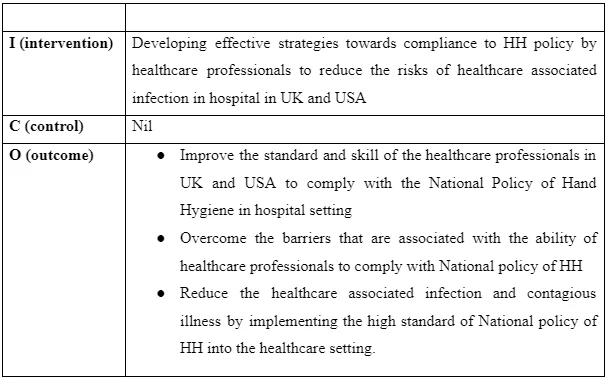
Literature review and methodology:
This is the secondary research study in which the researchers have the systematic review of the selected primary research papers. A systematic review is the process of summarising the contents of previous research papers research papers on a particular research topic (Stanley and Stanley, 2018). In this systematic review, the researcher has reviewed and analyse the content presented in the selected primary research articles thereby synthesizing a comprehensive and evidenced based discission on the selected topic (compliance with the national policed of hand hygiene HH).
For conducting this systematic review, researcher has selected the reverent research paper by following the relevant online database and relevant Boolean operators. Moreover, inclusion and exclusion criteria are also used by the researcher to select the highly appropriate primary research articles on the research topic. In this systematic review, researchers have done systematic analysis and evaluation of the of evidences presented in the selected research paper thereby synthesizing a comprehensive summary of the evidence-based content. In the systematic literature review, research have used the relevant evidences to support important statement on the national policies of HH and its implementation into healthcare practices.
Take a deeper dive into National Health Service (NHS) in the United Kingdom with our additional resources.
Search strategy:
As mentioned by Eriksen and Frandse (2018), a good research study must present a clear and concise research strategy. Here the researcher has used different appropriate online database such as ebscohost Research database, PubMed, CINAHL, find@Greenwich, British National Index (BNI) and Psych info. Here researcher has used apporpriate key words in terms of searching for the relevant research papers on the research topic. Boolean operators are also used to narrow or expand the literature search. Although psych info is used by the researcher to search for primary research papers, after obtaining the search result by using this psych info, it is seen that majority of the research papers are duplicated and repeated. This is why the literature search by using psych info is removed by the researcher to maintain that authenticity and validify of the search study. Following key words have been used by researcher while using the online database to select the relevant research papers.
The first search had been generated by using the key words ‘hand Hygiene’ and compliance’ which resulted into a total of 722. Then a second search had been generated by using the key words such as national policy, healthcare professionals, healthcare associated infection and hand care. This second search resulted to total of 470 research articles. After this search it had been sea the not all the research papers that had been retrieved from the search are relevant to this research study. Then a third search had been conducted in which the five years’ time scale (2016-2021) had been set to collect only those research articles that had been published within the five-year period. The third search resulted to 115 research articles. After conducting this third search it was seen that not all research articles are in English or fully accessed or have relevant research elements. Therefore, a fourth search was conducted in which English had been set as the prime language. This fourth search narrowed the search result to only 75 research articles. Then the fifth search had been generated in which screening of the all the research papers was done to determine the validity and authenticity of each research element of each research paper. This fifth search resulted to 30 research papers. After then the six searches had been conducted to determine the validity and relevance of the literature review and references list of each selected research papers which then resulted to only 14 research articles. Then the seventh search was generated to check the validity and authenticity of the abstract of each research which ten resulted to 8 research articles. Finally, 8 research articles had been retrieved from the literature. [refers to appendix 1 PRISAMA diagram]
Key words:
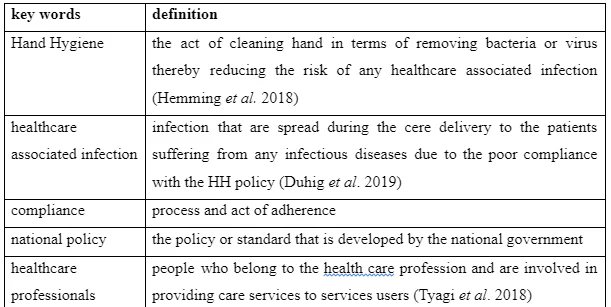

Key words for the brain storming and mind mapping:

Inclusion and exclusion criteria:
For conducting any literature search researchers need to use appropriate inclusion and exclusion criteria. As mentioned by Tyagi et al. (2018), inclusion and exclusion criteria provide the research of any research study with a check list that assists the researcher to select only the research papers that meet all those criteria of the check list.
in this research study researcher has set the 10 years times framer for selecting the appropriate research peppers. Under this criterion the research papers that are published within 2011–2021-time frame is selected for this research study, evidence suggests that, researchers must use the pre-set time framework while selecting the research papers to ensure that the information that are collected from the research papers is relevant to the current healthcare context (Eriksen and Frandsen, 2018). The 10 years times frame has been set in this research study to ensure the transferability of database of the selected literature, as mentioned by 0m transferability of database means if all the other variables remain same variables remain same, then the evidence-based content of research study can be used in any other study on the same research topic. Here, English is set as the prime language for selecting research papers. Here the researcher papers that are not in English are excluded from the list. The accessibility of the research papers has been also included in the inclusion criteria. Research papers that cannot be freely accessed over the internet are excluded from the list. Then analysis and screening of selected research papers are done to check the relevance of het contents, research element and the reference list of research papers.
Boolean operators (Limiters or expanders):
Boolean operators are highly useful in any systematic review that assists the researcher to expand or narrow the literature search, though using different types of Boolean operator, researcher is able to limit the search of the search result is more than enough or can expend the literature search of the search result is not sufficient for carrying out a successful research (Eriksen and Frandsen, 2018).
Here the researcher has used all the three Boolean operators such as AND, OR and NOT. AND’ and ‘NOT operators are used as the limiters that are used to narrow the search result. On the other hand, the OR operator is used by the researcher to expand the literature, along with the highly relevant key words. Other related key words that are related to the research topic are also used in the search of relevant research papers; this is because it is seen that by using only relevant key words the search result that is generated is too small to get the enough information to address all the research questions. Therefore, maintaining the generalisability, the related key words are also used to expand the literature search. The key words that ae used with Boolean operators are as follows:
Hand Hygiene OR* healthcare associated infection *OR compliance *AND healthcare professionals *AND infection *OR hand care* OR national policy *NOT morbidity * AND mortality *AND bacterial infection *OR bacterial colonisation *AND virus infection *OR patient safety *AND compassionate care
Result
By conducting systematic review of the selected literature two themes have been identified. These themes are
Theme 1: Standards and procedures of the National Policy on Hand Hygiene needs to be implemented and followed by that HCPs in terms of maintaining proper HH:
Theme 2: the challenges or barriers the healthcare professions experiences while implementing HH policy into practices
Theme 3: The effective strategies and ways that can be used to motivate HCPs to comply with the national policy of HH
Themes:
Standards and procedures of the National Policy on Hand Hygiene needs to be implemented and followed by that HCPs in terms of maintaining proper HH:
Under National Policy on Hand Hygiene, HCPs need to follow and implement all the standard inro their practices to eliminate the risk of any healthcare associated infection (Sadule-Rios and Aguilera, 2017). HCPs in the UK are obliged to follow the systematic process of HH throughout the care delivery to patients. In case of treating patients with infectious wounds in which there is high chances of bacterial colonisation, HCPs need to ensure all the safety standard are met under the national Policy of Hand Hyginus (HH). Thorough complying with all the safety standard under the national policy of HH, HCPs are able to maintain the aseptic environment surrounding the patient which reduce chances of spreading of any bacterial infection to the other people from the patient. As mentioned by Gould et al. (2018), there are different kind of heartcare associated infection such as the needle stick infection which cause case the spreading of the infection from one body to the other.
NHS (2019) mentioned that that many cases have been registered in the NHS hospital in which both the healthcare staffs and patients are infected with the needle stick infection while collecting blood from patient’s body. The standard that HCPs need to maintain throughout their care delivery to patients are washing hands for more than 30 seconds by using soap and hand wash (Lambe et al. (2019). Antiseptic hand wash is highly recommended under the national policy for HCPs to eliminate risks of any germ or bacteria in their hand. Under the national policy, HCPs need to use the aseptic techniques to maintain hygiene and bacteria free environment surrounding the patients which will restrict the entry of the bacteria or infections from one patient to the other. In this context, HCPs need sterilise the medical equipment such as needle, forceps, syringe and other clinical instruments before and after using them in patient body. On the other hand, HCPs need to be highly skilled and well-trained in using the medical processes with perfection such as dressing or collecting blood from patients’ body in terms of ensuring there is no chances of any blood borne infection.
Challenges or barriers the healthcare professions experiences while implementing HH policy into practices:
As mentioned by Allegranzi et al. (2017), while implementing the HH policy HCPs face several challenges that pose adverse impacts not only on their professional integrity as well as professional accountability but also impact on their mental and physical wellbeing. One of the most common challenges that HCPs face is lack of skill and professional knowledge of the healthcare staffs about how to follow and implement the standard of the national policy of Hand hygiene. Seeking healthcare dissertation help can provide valuable insights into overcoming these challenges and enhancing compliance with the policy. NHS (2019) mentioned that, due to lack of skilled staffs and knowledgeable as well as experienced HCPs in the NHS hospitals, the numbers of healthcare associated infection are increasing over years. NICE (2019) mentioned that healthcare authority needs to arrange training and developmental program for the healthcare staffs in which they will be provided with the professional knowledge on how to use the systematic process of HH to eliminate the risk of any infection.
Another most common barrier that HCPs experiences in their workplace while implementing HH policy into practices is the lack of cooperation from patients. In this context Livorsi et al. (2018) mentioned that there are many such cases in which HCPs do not get any assistance or corporation from patients while treating the wound or ulcer. NHS (2019) mentioned that many cases of the blood borne infection to the health staffs have been registered in the NHS hospitals in which due to the negligence of patients in cleaning their hand properly while the dressing is conducted cause this infection.
Another common barrier that HCPs face lack of resources and infrastructure in the healthcare organisation to implement all the standard of national policy of HH [NHS, 2019]. NHS staffs reported to face severe difficulties in dressing the infectious wound of patients due to the lack of proper aseptic techniques and tools in the hospitals. In recent year NHS hospitals face severe challenges of fund shortage and poor as well as backdated healthcare infrastructure that make if difficult for the HCPs to implement and follow the standard set under the national policy of HH.
The effective strategies and ways that can be used to motivate HCPs to comply with the national policy of HH:
The government of US ad UK have developed effective strategies and ways that can be used to motivate HCPs to comply with the national policy of HH. As mentioned by Alzyood et al. (2018), one of the important strategies is skill development training and healthcare education to HCPs. In the UK, effective training and skill development program have been arranged for HCPs that will make them learn about all the standard set under the national policy of hand hygiene and the processes that are used for following all the standard systematically to ensure patient’s safety. In this context Lambe et al. (2019) mentioned that another important strategy in improving the complying ability of the HCPs is arranging reward system. The author mentioned that, in this is reward system all the HCPs who have successfully met all the standard under the national policy of HH will be rewarded. The reward can be appreciation, the remuneration hike, the bonus, incentives and effectives career development opportunities for HCPs. On the other hand, Ojanperä et al. (2020) mentioned that, HCPs needs to be provided with positive and supportive work environment in which they will work synergically with their seniors and subordinate. In this synergetic environment, HCPs can share their understanding, decision, knowledge and work process regarding implementing and complying with HH policy that will improves the process of HH thereby ensuring patent’s safety.
Discussion (critical analysis):
In this critical analysis part this research study will use the CASP tool to critically analyse the selected research papers. The critical appraisal skill program or CASP tool is widely used tool in the secondary research study that assist researchers to compare and analyse the database of the selected research papers in order to determine the authenticity and genuineness (Carpenter and Glasper, 2021). The findings of this LR present three major aspects that are associated with maintaining proper HH in the healthcare. These three themes that are identified are: the standard set under the national policy of HH that need to be comply with and followed by HCPs, the challenges that HCPs face during complying with HH policy and the strategies that can be used to motivate HCPs for improving thief ability and skill to comply with the HH policy.
The first theme has several evidences which present the procedure and tolls that are used by HCPs for implementing the national policy of HH into practices to maintain patients’ safety in the UK and US. Allegranzi et al. (2017), stated in their research study that, the standard set under the National Policy of Hand Hygiene needs to be followed as well as implemented by the HCP into their practice thereby eliminating the chances of any kind of bacterial infection. On the contrary critics argued that, due to the severe workload and poor task delegation system in the healthcare, many times HCPs are not able to comply with all the principles and values set under the national policy of HH which then interfere with their professional integrity and accountability towards patient’s safety (Sadule-Rios and Aguilera, 2017).
On the other hand, Alzyood et al. (2018) present comprehensive discission on how HCP use their skill and professional knowledge in terms of using the systematic process of HH thereby complying with all the standard set under the national policy of HH in the US and UK (Jonker. and Othman 2018). On the contrary Chatfield et al. (2017) argued that, along with developing the skills and competence level in complying with the National Policy of HH, HCPs must undertake the training and development program in their workplace regarding how to deal wit the barriers associated with complying with the HH policy.
On the contrary the findings of this LR it is obtained that HCPs needs to be careful while following the procedures of complying with HH policy in terms of ensuring that there is no risk of blood borne infection or other healthcare infection. The findings also show that HCPs need to understand the level of competence and skill that they must have for maintaining patient’s safety while complying with the national policy of HH.
The second theme contains several evidences that identify the challenges as well as impediments that the HCP face in the professional field while complying with the national policies of HH (Sadule-Rios and Aguilera, 2017).
Chatfield et al. (2017) conducted a feed intervention trial (FIT) and randomised control trial to highlight the potential barriers that are associated with the failure of HCPs in implementing and complying with national policy of HH. Psychological theories are also used in this theme to discuss the impacts on the challenges and barriers on the psychological and emotional welling of HCP.
Alternatively, the finding of Garcell et al. (2017) shows that, HCPs face several barriers such as lack of skilled and knowledgeable staffs, the lack of cooperation and assistance from the patients as well as from the senior healthcare authority and poor infrastructure in healthcare organisation (Lambe et al. 2019). Gould et al. (2018) presented the strategies that can be used by HCPs to overcome these barriers such as attending trading and skill development program, working synergistically with seniors and subordinates and building healthy as well as friendly relation with patients.
In the third theme, Goyal et al. (2020) presented the strategies that can be used to improves the skill and professional knowledge of HCP on how to compliance with the national policy of HH (Livorsi et al. 2018). Through improving the compliance with HH policy, HCP can promote the positive health and wellbeing of patient. Jeanes et al. (2018) presented ways in which the HCP can be advised and guided through providing them with proper training and skill development opportunities for improving the knowledge on monitoring of heath care infection in patients and maintain all the HH standard set under the national policy to ensure patients safety.

Conclusion:
From the above-mentioned discussion it can be concluded that, HH is one of the most important aspect in healthcare in terms of eliminating the risk of different healthcare associated infection such as the needle stick infection and blood borne infection. HCPs must ensure that they have good understating on the standards that are set under the National Policy of HH. Nurses must ensure that they work under their level of competence and professional knowledge in following all the guidelines under the national policy of HH in terms of ensuring patient safety. Thorough motivating HCPs for complying with the HH policy, it is possible to prevent the risk of different healthcare associated infection. On the other hand, though providing proper support and training the healthcare staffs and nurses it is possible to improve their capacity in complying with the standard set under the national policy of HH. While complying with national policy of HH, hcps must ensure that they are aware of all the principles and values set under the National Policy for HH. In this context, the healthcare authority needs to conduct effective training and development program that will enable the hcps to develop their professional knowledge regarding use of tools and techniques that can be applied in the healthcare practices to comply with all the principles and codes under the National Policy of HH. Additionally, hcps must have the clear understanding on how effectively the healthcare techniques can be used to avoid the risk of any kind of healthcare infection such as the needle stick infection during the collection of body sample and blood from patient. Most importantly, hcps must consider the barriers and facilitators that are associated with the compliance with HH policy, the barriers are the lack of skill and understanding of healthcare staffs, the lack of resources and insufficient infrastructure and lack of training in the healthcare centre. On the other hand, the facilitators of the compliance with HH policy are highly organised healthcare framework, high quality care delivery system, good safeguarding environment for patients, good training and developmental opportunities in healthcare organisation and presence of high skilled and well-trained healthcare professionals. In this context, hcps must emphasize on developing the effective strategies to improves their professional skill in eliminating all the barriers thereby developed a well-structured to comply with all the principles under the HH policy
Reference list:
Allan, J., 2017. An Analysis of Albert Bandura's Aggression: A Social Learning Analysis. CRC Press.
Allegranzi, B., Stewardson, A.J. and Pittet, D., 2017. Compliance with hand hygiene best practices. Hand hygiene: a handbook for medical professionals, 1, pp.76-84.
Alqahtani, A.S., Fakeerh, M., Bondagji, D., Park, S., Heywood, A.E., Wiley, K.E., Booy, R. and Rashid, H., 2020. Hand hygiene compliance and effectiveness against respiratory infections among Hajj pilgrims: A systematic review. Infectious Disorders-Drug Targets (Formerly Current Drug Targets-Infectious Disorders), 20(3), pp.273-283.
Alzyood, M., Jackson, D., Brooke, J. and Aveyard, H., 2018. An integrative review exploring the perceptions of patients and healthcare professionals towards patient involvement in promoting hand hygiene compliance in the hospital setting. Journal of clinical nursing, 27(7-8), pp.1329-1345.
Brown, D., 2020. A review of the PubMed PICO tool: using evidence-based practice in health education. Health promotion practice, 21(4), pp.496-498.
Carpenter, D. and Glasper, A., 2021. Critically Chapter 19 reviewing quantitative papers using a CASP critiquing tool. How to Write Your Nursing Dissertation, p.207.
Cawthorne, K.R., Dean, J. and Cooke, R.P., 2020. The financial impact of improved hand hygiene on healthcare-associated infections in the UK. Canadian Journal of Infection Control, 35(3).
Chatfield, S.L., Nolan, R., Crawford, H. and Hallam, J.S., 2017. Acute care nurses' responses and recommendations for improvement of hand hygiene compliance: A cross-sectional factorial survey research study. American journal of infection control, 45(6), pp.620-625.
Duhig, K.E., Myers, J., Seed, P.T., Sparkes, J., Lowe, J., Hunter, R.M., Shennan, A.H., Chappell, L.C., Bahl, R., Bambridge, G. and Barnfield, S., 2019. Placental growth factor testing to assess women with suspected pre-eclampsia: a multicentre, pragmatic, stepped-wedge cluster-randomised controlled trial. The Lancet, 393(10183), pp.1807-1818.
Dyson, J. and Madeo, M., 2017. Investigating the use of an electronic hand hygiene monitoring and prompt device: influence and acceptability. Journal of infection prevention, 18(6), pp.278-287.
Eriksen, M.B. and Frandsen, T.F., 2018. The impact of patient, intervention, comparison, outcome (PICO) as a search strategy tool on literature search quality: a systematic review. Journal of the Medical Library Association: JMLA, 106(4), p.420.
Evans, E.W. and Redmond, E.C., 2019. Video observation of hand-hygiene compliance in a manufacturer of ready-to-eat pie and pastry products. International journal of environmental health research, 29(6), pp.593-606.
Garcell, H.G., Arias, A.V., Miranda, F.R., Jimenez, R.R. and Serrano, R.N.A., 2017. Direct observation of hand hygiene can show differences in staff compliance: Do we need to evaluate the accuracy for patient safety?. Qatar medical journal, 2017(2), p.1.
Gould, D., Lindström, H., Purssell, E. and Wigglesworth, N., 2020. Electronic hand hygiene monitoring: accuracy, impact on the Hawthorne effect and efficiency. Journal of Infection Prevention, 21(4), pp.136-143.
Gould, D., Moralejo, D., Drey, N., Chudleigh, J. and Taljaard, M., 2018. Interventions to improve hand hygiene compliance in patient care: Reflections on three systematic reviews for the Cochrane Collaboration 2007–2017. Journal of infection prevention, 19(3), pp.108-113.
Gould, D.J., Creedon, S., Jeanes, A., Drey, N.S., Chudleigh, J. and Moralejo, D., 2017. Impact of observing hand hygiene in practice and research: a methodological reconsideration. Journal of hospital infection, 95(2), pp.169-174.
Gould, D.J., Navaïe, D., Purssell, E., Drey, N.S. and Creedon, S., 2018. Changing the paradigm: messages for hand hygiene education and audit from cluster analysis. Journal of Hospital Infection, 98(4), pp.345-351.
Goyal, A., Narula, H., Gupta, P.K., Sharma, A., Bhadoria, A.S. and Gupta, P., 2020. Evaluation of existing knowledge, attitude, perception and compliance of hand hygiene among health care workers in a Tertiary care centre in Uttarakhand. Journal of Family Medicine and Primary Care, 9(3), p.1620.
Greenaway, R.E., Ormandy, K., Fellows, C. and Hollowood, T., 2018. Impact of hand sanitizer format (gel/foam/liquid) and dose amount on its sensory properties and acceptability for improving hand hygiene compliance. Journal of Hospital Infection, 100(2), pp.195-201.
Hammerschmidt, J. and Manser, T., 2019. Nurses’ knowledge, behaviour and compliance concerning hand hygiene in nursing homes: a cross-sectional mixed-methods study. BMC health services research, 19(1), pp.1-13.
Hemming, K., Taljaard, M., McKenzie, J.E., Hooper, R., Copas, A., Thompson, J.A., Dixon-Woods, M., Aldcroft, A., Doussau, A., Grayling, M. and Kristunas, C., 2018. Reporting of stepped wedge cluster randomised trials: extension of the CONSORT 2010 statement with explanation and elaboration. bmj, 363.
Jeanes, A., Coen, P.G., Drey, N.S. and Gould, D.J., 2018. The development of hand hygiene compliance imperatives in an emergency department. American journal of infection control, 46(4), pp.441-447.
Jeanes, A., Dick, J., Coen, P., Drey, N. and Gould, D.J., 2018. Hand hygiene compliance monitoring in anaesthetics: Feasibility and validity. Journal of infection prevention, 19(3), pp.116-122.
Jeanes, A., Henderson, F., Drey, N. and Gould, D., 2019. Hand hygiene expectations in radiography: A critical evaluation of the opportunities for and barriers to compliance. Journal of Infection Prevention, 20(3), pp.122-131.
Jones, S., Reay, S., Bull, D. and Gray, J., 2017. Hand hygiene compliance monitoring: we need to stop kidding ourselves. Journal of Hospital Infection, 97(1), pp.33-34.
Jonker, C. and Othman, M., 2018. Hand Hygiene Among Hospital Staff: A Survey of Knowledge, Attitude, and Practice in A General Hospital in Syria. Jurnal Keperawatan Indonesia, 21(3), pp.139-149.
Labrague, L.J., McEnroe‐Petitte, D.M., Van de Mortel, T. and Nasirudeen, A.M.A., 2018. A systematic review on hand hygiene knowledge and compliance in student nurses. International nursing review, 65(3), pp.336-348.
Lambe, K.A., Lydon, S., Madden, C., Vellinga, A., Hehir, A., Walsh, M. and O’Connor, P., 2019. Hand hygiene compliance in the ICU: a systematic review. Critical care medicine, 47(9), pp.1251-1257.
Lawson, A. and Vaganay-Miller, M., 2019. The Effectiveness of a Poster Intervention on Hand Hygiene Practice and Compliance When Using Public Restrooms in a University Setting. International journal of environmental research and public health, 16(24), p.5036.
Livorsi, D.J., Goedken, C.C., Sauder, M., Vander Weg, M.W., Perencevich, E.N. and Reisinger, H.S., 2018. Evaluation of barriers to Audit-and-Feedback programs that used direct observation of hand hygiene compliance: a qualitative study. JAMA network open, 1(6), pp.e183344-e183344.
Lydon, S., Power, M., McSharry, J., Byrne, M., Madden, C., Squires, J.E. and O’Connor, P., 2017. Interventions to improve hand hygiene compliance in the ICU: a systematic review. Critical care medicine, 45(11), pp.e1165-e1172.
Mostafazadeh-Bora, M., Bahrami, M. and Hosseini, A., 2018. A survey of nurses' compliance with hand hygiene guidelines in caring for patients with cancer in a selected center of Isfahan, Iran, in 2016. Iranian journal of nursing and midwifery research, 23(2), p.119.
NICE, [2019], Hand decontamination, available at:
NMC (2019), Available at:
Ojanperä, H., Kanste, O.I. and Syrjala, H., 2020. Hand-hygiene compliance by hospital staff and incidence of health-care-associated infections, Finland. Bulletin of the World Health Organization, 98(7), p.475.
Oliver, C., Thompson, A. and Cooke, R.P.D., 2017. In defence of high hand-hygiene compliance rates. The Journal of hospital infection, 97(1), pp.31-32.
Pfäfflin, F., Tufa, T.B., Getachew, M., Nigussie, T., Schönfeld, A., Häussinger, D., Feldt, T. and Schmidt, N., 2017. Implementation of the WHO multimodal hand hygiene improvement strategy in a University Hospital in Central Ethiopia. Antimicrobial Resistance & Infection Control, 6(1), pp.1-10.
PHE (2019) Hand Hygiene for general practice available at:
Pittet, D., Boyce, J.M. and Allegranzi, B. eds., 2017. Hand hygiene: a handbook for medical professionals. John Wiley & Sons.
Rajbhandari, M.M.S., 2018. Obstinate Actions-Oriented Behaviour towards Applying Theoractive Learning: An Ontology of Educational Learning and Leadership Theories in Practice. Online Submission, 7(1), pp.18-28.
Sadule-Rios, N. and Aguilera, G., 2017. Nurses’ perceptions of reasons for persistent low rates in hand hygiene compliance. Intensive and Critical Care Nursing, 42, pp.17-21.
Sands, M. and Aunger, R., 2020. Determinants of hand hygiene compliance among nurses in US hospitals: A formative research study. Plos one, 15(4), p.e0230573.
Shah, A.S., Anand, A., Strachan, F.E., Ferry, A.V., Lee, K.K., Chapman, A.R., Sandeman, D., Stables, C.L., Adamson, P.D., Andrews, J.P. and Anwar, M.S., 2018. High-sensitivity troponin in the evaluation of patients with suspected acute coronary syndrome: a stepped-wedge, cluster-randomised controlled trial. The Lancet, 392(10151), pp.919-928.
Smith, C., 2021. How practical drift and cognitive biases impact hospital hand hygiene compliance. British Journal of Healthcare Management, 27(1), pp.12-14.
Stanley, D. and Stanley, K., 2018. Clinical leadership and nursing explored: A literature search. Journal of clinical nursing, 27(9-10), pp.1730-1743.
Tartari, E., Pires, D., Bellissimo-Rodrigues, F., De Kraker, M., Borzykowski, T.H., Allegranzi, B. and Pittet, D., 2017. The global hand-sanitizing relay: promoting hand hygiene through innovation. Journal of Hospital Infection, 95(2), pp.189-193.
Tyagi, M., Hanson, C., Schellenberg, J., Chamarty, S. and Singh, S., 2018. Hand hygiene in hospitals: an observational study in hospitals from two southern states of India. BMC public health, 18(1), pp.1-9.
Appendices:
Appendix 1: PRISMA Tool:
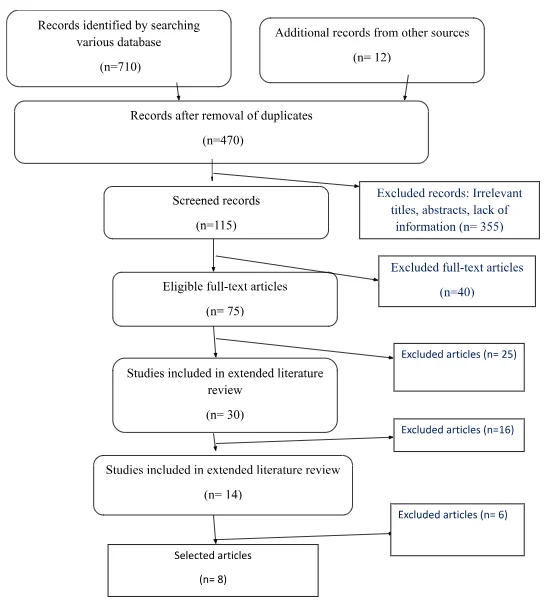
Appendix 2:
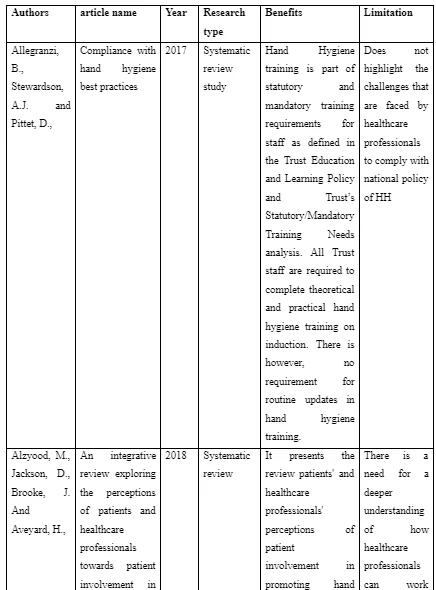
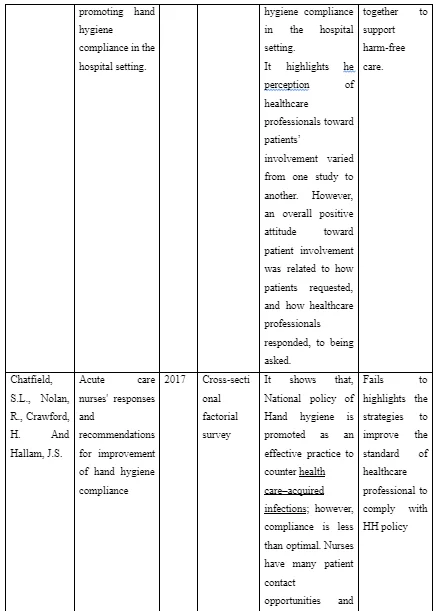
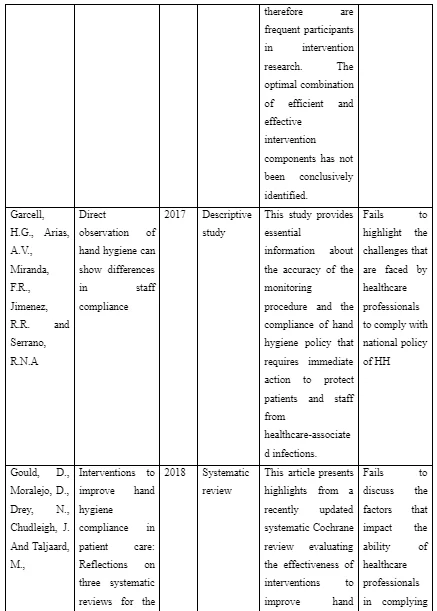
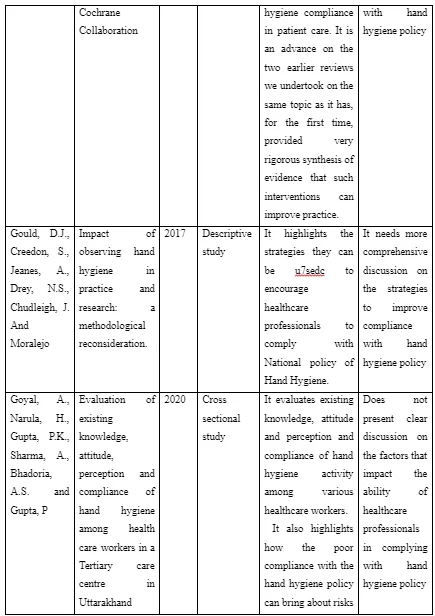
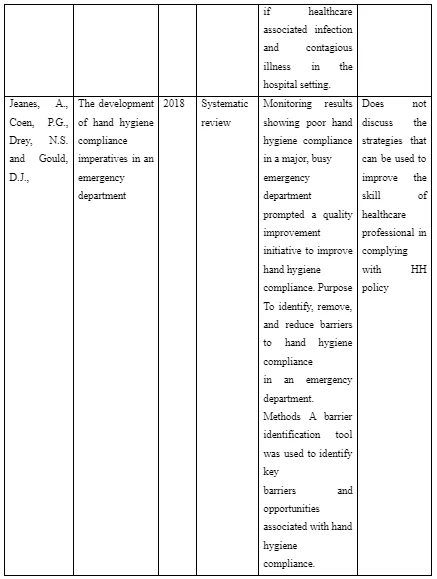
- 24/7 Customer Support
- 100% Customer Satisfaction
- No Privacy Violation
- Quick Services
- Subject Experts



